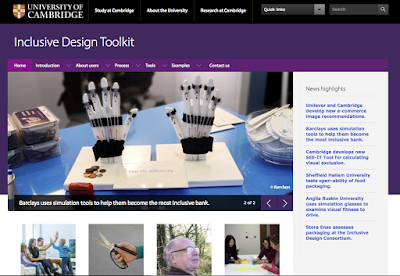Let's look at #4 on the list.
4. Research the benefits of inclusive design
This has been a personal crusade point of mine for the last couple of years. I've written several blog posts and given a few talks about the benefits of Inclusive Design. In short, Inclusive Design is "good design for everyone", or at least the largest number of people possible.
Accessibility is making sure that information and online experiences are available to everyone, including using technology to bridge the gap where necessary (screen readers, closed captioning, speech recognition, etc.).
Inclusive Design happens before these extra technologies are required. It can certainly leverage them and help make that "last mile" experience a good one, but the goal with Inclusive Design is to help design experiences that don't require special accommodations. When sites are optimizing for color blind users, yes, those optimizations do indeed help those who are color blind. It also helps make a site clearer and more defined for normative users, too. Making a site that has a consistent tab order and that follows standard keyboard conventions likewise helps all users.
My favorite description of "What is Inclusive Design?" can be found as part of the Inclusive Design Toolkit, which is a series of articles and tools sponsored by the University of Cambridge.
I'm going to quote this section specifically, not so much as to the "what" but as to the "why":
"The majority of new product development projects focus on time and budget. However, this focus can conflict with delivering the most commercially successful product.
There is often the perception that design effort should be minimised in order to reduce cost and shorten timescales. In reality, the true costs of bad design (such as warranty returns from unsatisfied customers) emerge later on in the product life cycle, and have the potential to cause irreparable damage to the brand image through customer frustration."
"One costly example of insufficient accommodation of user diversity relates to the US Treasury. A court ruled that the Treasury discriminated against the blind and visually impaired by printing all denominations of currency in the same size and texture. Following this ruling, in 2011 the Treasury approved adding tactile features to US notes (Bureau of Engraving and Printing, 2011) at an estimated cost of $6.6 billion (ARINC, 2009). Subsequently, this proposal was changed to distributing free currency reader devices to eligible blind and visually impaired individuals, still at significant cost."
Additionally, to see me take a crack at discussing Inclusive Design in a recent talk, I presented "Making a Web for Everyone: Designing and Testing for Accessibility" at Agile Testing Days in Potsdam, Germany in November 2015. In it, I discuss several advantages of Inclusive Design, and what I felt at the time was a good example of it (i.e. the LoseIt! app as it appears on iPhone).
To close this out, the real win of Inclusive Design is the fact that we are proactively making considerations for the largest number of people to use our products effectively. Some may say that this will cost more, but I would argue that the costs of not using Inclusive Design principles may be much more expensive and longer lasting, as getting back reputation lost because of poor design may be impossible. These rules work in the world of toys, the garage, and the kitchen. They also work for software and the devices we have come to depend on. Let's make the most of it.

No comments:
Post a Comment